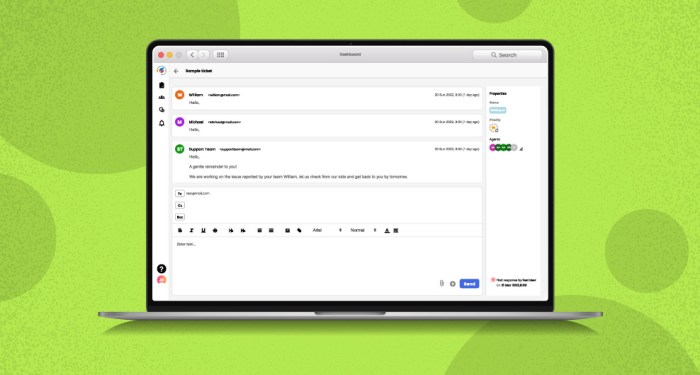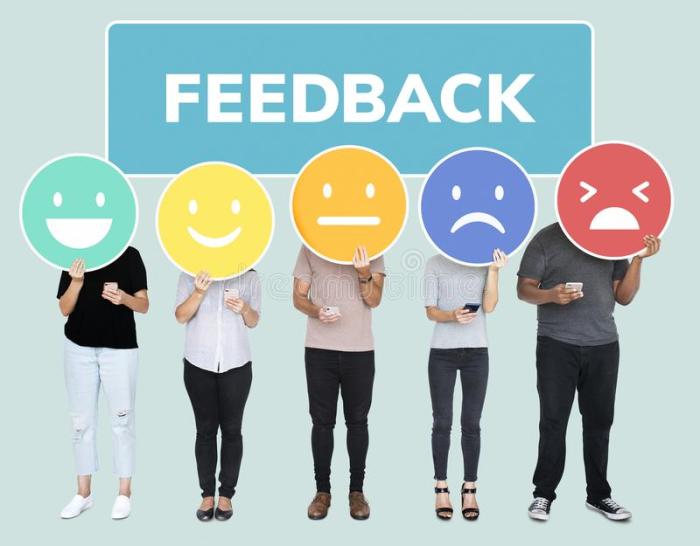Building a Customer Feedback Loop sets the stage for improved business strategies, offering a sneak peek into the world of customer-centric approaches that drive success. Get ready to dive into the realm of feedback mastery!
In today’s fast-paced market, understanding the pulse of your customers is crucial for staying ahead of the competition. Building a solid feedback loop can be the game-changer your business needs to thrive and grow.
Introduction to Building a Customer Feedback Loop

A customer feedback loop is a process that involves collecting, analyzing, and implementing feedback from customers to improve products, services, and overall customer experience. It is crucial for businesses as it allows them to understand customer needs, preferences, and pain points, ultimately leading to increased customer satisfaction and loyalty.
A well-structured feedback loop can benefit a company by helping them make data-driven decisions, identify areas for improvement, and build stronger relationships with customers. By actively seeking and listening to feedback, companies can stay ahead of the competition and continuously innovate to meet changing customer demands.
Examples of Successful Implementation
- Amazon: Amazon uses customer feedback to enhance product listings, improve delivery services, and personalize recommendations, leading to a seamless shopping experience for customers.
- Apple: Apple gathers feedback through surveys, reviews, and customer support interactions to refine its products, software updates, and customer service, maintaining high levels of customer satisfaction and loyalty.
- Starbucks: Starbucks leverages customer feedback to introduce new menu items, optimize store layouts, and train baristas, creating a welcoming environment that keeps customers coming back for more.
Creating a Feedback Collection Strategy
When it comes to building a customer feedback loop, having a solid feedback collection strategy is crucial. This involves determining the methods for gathering feedback, selecting the right channels, and encouraging customers to share their thoughts.
Different Methods for Collecting Customer Feedback
- Surveys: Creating online surveys to gather structured feedback from customers.
- Interviews: Conducting one-on-one interviews to get in-depth insights and opinions.
- Social Media Monitoring: Tracking social media platforms to listen to what customers are saying about your brand.
- Feedback Forms: Providing forms on your website or in-store for customers to share their feedback.
Choosing the Right Feedback Collection Channels
- Consider the demographics of your target audience to determine which channels they are most active on.
- Use a mix of channels to reach a wider range of customers and gather diverse feedback.
- Test different channels to see which ones yield the most valuable insights for your business.
Encouraging Customers to Provide Feedback
- Offer incentives such as discounts or giveaways for customers who participate in providing feedback.
- Make it easy for customers to share their thoughts by providing multiple feedback channels.
- Show appreciation for feedback received and demonstrate how it has helped improve your products or services.
Analyzing and Interpreting Feedback Data
![]()
Analyzing and interpreting feedback data is crucial for businesses to understand customer perceptions and areas for improvement. By following effective steps, categorizing feedback, and using sentiment analysis, companies can extract valuable insights from customer feedback.
Steps for Analyzing Feedback Data Effectively
- Collect feedback from various sources such as surveys, reviews, and social media.
- Organize feedback based on common themes or topics to identify trends.
- Analyze quantitative data using metrics like Net Promoter Score (NPS) or Customer Satisfaction Score (CSAT).
- Utilize qualitative data to gain deeper insights into customer sentiments and experiences.
- Create visualizations like charts or graphs to present data in a clear and concise manner.
Importance of Categorizing Feedback for Better Analysis
Categorizing feedback allows businesses to streamline the analysis process by grouping similar feedback together. This helps in identifying patterns, trends, and areas of concern more efficiently. By categorizing feedback, companies can prioritize actions based on the most common or critical issues highlighted by customers.
Using Sentiment Analysis to Interpret Customer Feedback, Building a Customer Feedback Loop
Sentiment analysis involves using natural language processing to determine the emotions and opinions expressed in customer feedback. By analyzing the sentiment of feedback (positive, negative, or neutral), businesses can gauge overall customer satisfaction, identify areas for improvement, and track changes in customer sentiment over time. Sentiment analysis provides a more nuanced understanding of customer feedback beyond just the words used, allowing businesses to respond effectively to customer needs and concerns.
Implementing Changes Based on Feedback: Building A Customer Feedback Loop
Implementing changes based on customer feedback is crucial for the growth and success of any business. Prioritizing feedback ensures that the most valuable insights are acted upon promptly. Communication of these changes to customers is equally important to show that their input is valued. Let’s explore how companies successfully implement changes based on feedback.
Prioritizing Feedback for Implementation
- Review feedback based on impact: prioritize changes that will have the most significant positive impact on the customer experience.
- Consider frequency: if multiple customers provide similar feedback, it may indicate a common issue that needs immediate attention.
- Assess feasibility: prioritize changes that are realistic and achievable based on available resources.
Strategies for Communicating Changes to Customers
- Be transparent: clearly communicate the changes being made and the reasons behind them to build trust with customers.
- Use multiple channels: reach out to customers through various channels such as email, social media, and website updates to ensure the message is received.
- Solicit feedback on changes: encourage customers to provide further input on implemented changes to show their opinions are valued.
Examples of Companies Implementing Changes Based on Feedback
- Amazon: Amazon constantly updates its website and services based on customer feedback, improving user experience and satisfaction.
- Apple: Apple frequently releases software updates addressing bugs and adding features requested by users, showing responsiveness to feedback.
- Starbucks: Starbucks introduced mobile ordering and payment options after receiving feedback from customers looking for more convenience in their coffee purchases.
Monitoring and Closing the Feedback Loop
Monitoring and closing the feedback loop is crucial in ensuring that customer feedback is acted upon effectively and that customers feel valued and heard. By continuously monitoring feedback loops and closing the loop with customers, businesses can improve their products, services, and overall customer satisfaction.
Importance of Continuous Monitoring
Continuous monitoring of feedback loops allows businesses to stay informed about customer sentiments, preferences, and needs in real-time. By actively tracking feedback, businesses can identify trends, address issues promptly, and make data-driven decisions to enhance the customer experience.
- Utilize feedback monitoring tools such as survey platforms, social media listening tools, and customer feedback management systems to collect and analyze feedback efficiently.
- Implement a regular cadence for reviewing and analyzing feedback data to ensure timely response and action.
- Engage with customers through various channels to gather feedback consistently and maintain an open line of communication.
Tools and Technologies for Monitoring Customer Feedback
There are several tools and technologies available to help businesses effectively monitor customer feedback and track customer satisfaction. These tools can streamline the feedback collection process, provide actionable insights, and facilitate communication with customers.
- Feedback management platforms like Zendesk, SurveyMonkey, and Medallia offer robust features for collecting, analyzing, and managing feedback data.
- Social media monitoring tools such as Hootsuite, Sprout Social, and Brandwatch enable businesses to track and respond to customer feedback on social media platforms.
- Customer relationship management (CRM) systems like Salesforce, HubSpot, and Zoho CRM help businesses centralize customer feedback and interactions for a holistic view of customer sentiment.
Best Practices for Closing the Loop
Closing the loop with customers after implementing changes based on their feedback is essential for demonstrating responsiveness and building trust. By following up with customers, businesses can show that their feedback is valued and that their input has led to meaningful improvements.
- Send personalized follow-up messages to customers who provided feedback, thanking them for their input and updating them on the changes made as a result.
- Request additional feedback or suggestions from customers to ensure that their needs are being met and to gather insights for future enhancements.
- Close the loop by informing customers of the actions taken based on their feedback and how it has positively impacted the customer experience.
